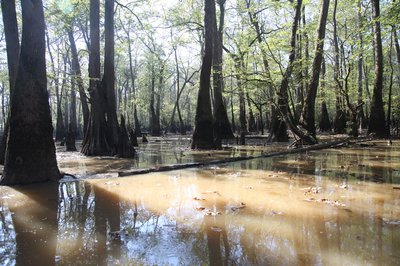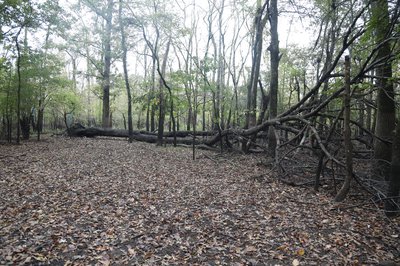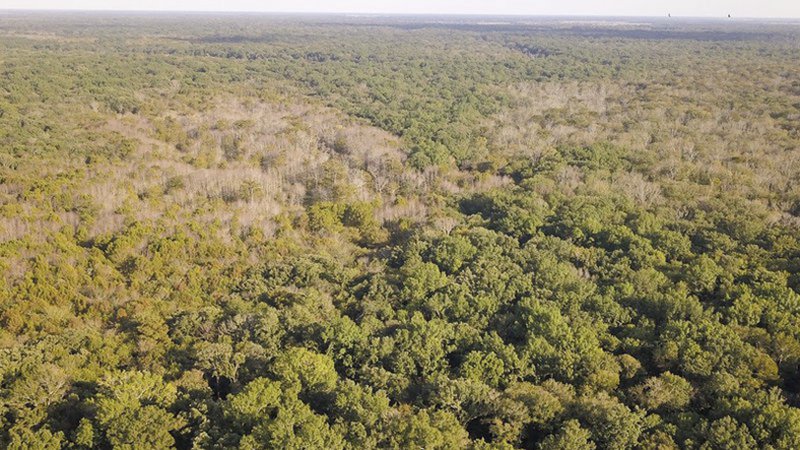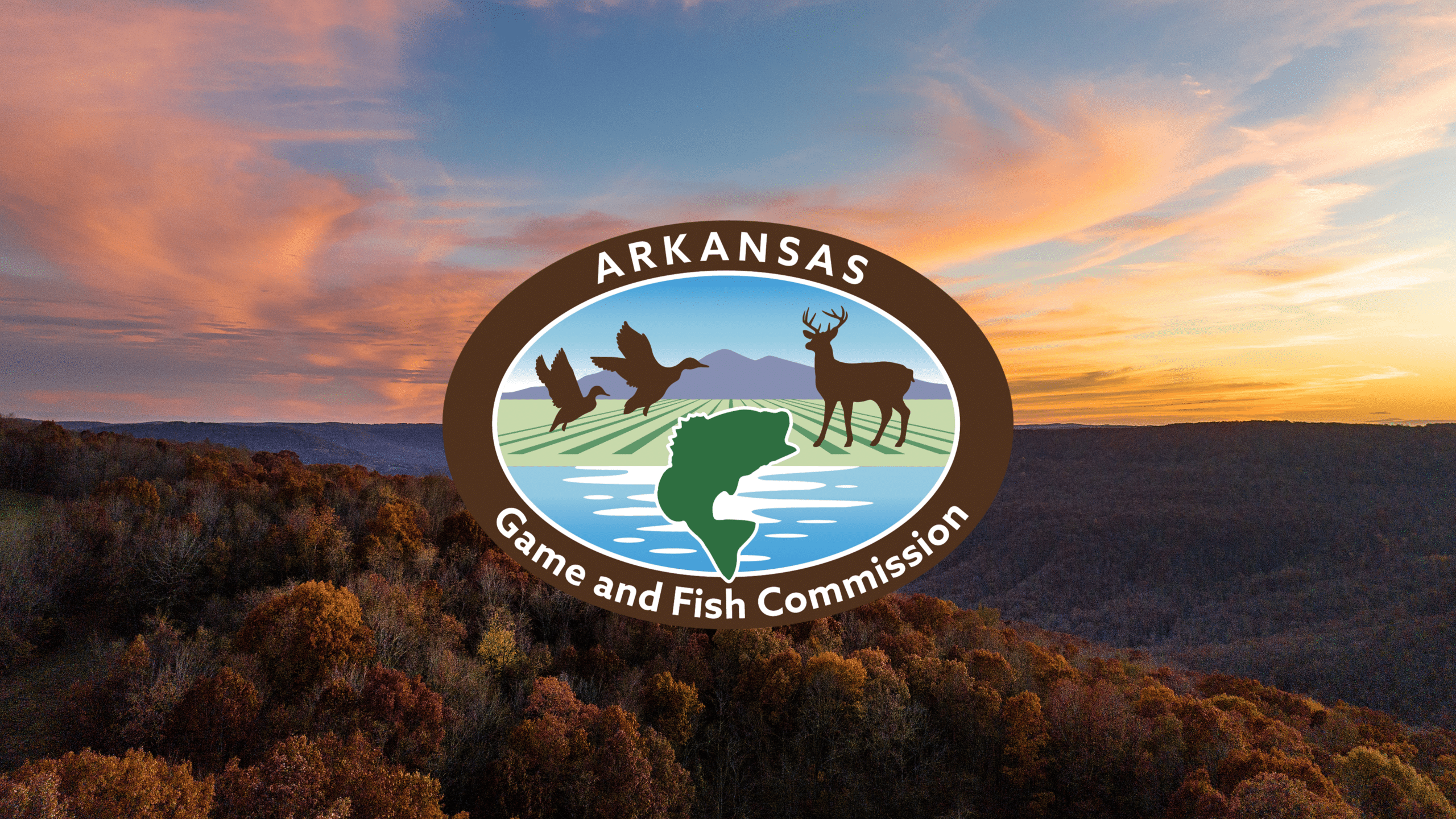Hurricane Lake WMA die-off attracts attention from congressmen, conservation partners
ON 11-02-2020

Nov. 2, 2020
Randy Zellers
Assistant Chief of Communications
BALD KNOB — United States congressmen French Hill and Bruce Westerman met with representatives from the Arkansas Game and Fish Commission and Ducks Unlimited under an overcast sky at Henry Gray Hurricane Lake Wildlife Management Area last Tuesday to talk about the future of green timber duck hunting in The Natural State.
The rainy weather was an omen of the dire situation facing conservationists within the WMA’s greentree reservoirs, a deadening of valuable wildlife habitat caused by excessive flooding during the last decade.

“Based on drone flights in 2019, we’re looking at roughly 800 acres of dead hardwoods on the north and south GTRs here and another 600 acres showing signs of severe stress that could be well on its way to dying if we don’t get some relief,” Brad Carner, chief of wildlife management for the AGFC, said while standing at the edge of the affected area. “These trees you see dying at the fringe continue well past where you can see from here, and they’re being replaced by more water-tolerant species that have very low value for wildlife. And this is just one of 40 GTRs we manage, all of which are in need of renovations to halt habitat losses currently occurring.”
Greentree reservoirs are a special habitat type created by intentional flooding of bottomland hardwoods when the trees are dormant during winter. This mimics the natural flood cycles that can occur during winter, making invertebrates, acorns and valuable shelter more available to migrating waterfowl, particularly mallards. Many systems of levees and water-control structures were constructed in the 1950s and beyond to reliably flood these areas each winter, providing this valuable habitat for waterfowl and creating the legendary duck-hunting opportunities for which Arkansas is famous.
Gradual changes in water cycles and shifts in land uses have altered the way water comes to and through these systems. Aging infrastructure and siltation also have played a role in slowing the flow of water on the land. Meanwhile, the forests themselves have begun to shift, with red oak species that offer food to waterfowl being replaced by more water-tolerant species of trees that do not produce the same food value for ducks seeking refuge in these flooded forests.
After decades of these systems facing slow but significant declines, major flooding during the growing season began to drive the final nail into the coffin at the south GTR on Henry Gray Hurricane Lake WMA. In 2018, trees that had held on the brink for too long finally gave out. In spring, they sprouted green leaves like normal, but within three months roughly 212 acres of trees in the interior of the GTR dropped those leaves and died. What was assessed in 2007 as one of the more healthy stands of bottomland hardwoods in the AGFC’s GTR system had reached the breaking point from too much water being placed on the area when the trees were not dormant.

“Much of the problem is how high the White River has been flowing in the last decade,” Carner said. “But we also need to address how quickly we can get that water off the area when we have the chance. All of our water-control structures have been evaluated and all of them throughout the entire GTR system are undersized for the amount of water we need to move.”
Much like a bathtub with a clogged drain, all of the water on the south GTR has to pass through a few small chokepoints on its way out of the system, and the drain simply can’t move the water fast enough to evacuate water when there is a chance to let the woods dry out.
“Where you’re standing right now has had water standing on it during most of the last year,” Carner said.
Luke Naylor, waterfowl program coordinator for the AGFC, said biologists have learned a lot in the last few decades about greentree reservoirs, and the mindset of how the systems are managed needs to be fundamentally changed.
“When these areas were first developed, the mindset was to find a way to hold water,” Naylor said. “We need to focus on moving the water through the system in a more natural way.”
Moving water across a system is much more of a challenge than simply damming a drain and holding it. It not only requires a complete revamping of the current infrastructure, but it also requires the cooperation of federal and private partners along Arkansas’s rivers to work together.
George Dunklin, former president of Ducks Unlimited who also served on the Arkansas Game and Fish Commission from 2005-2012, said the issue requires work not only on the greentree reservoir, but changes in the watershed both above and below these critical waterfowl habitats.
“The water needs a place to go, and water delivery begins at the bottom; it all works together,” Dunklin said. “And with Arkansas wintering more mallards than any other state, conservation of these areas doesn’t just impact hunters here, it has influence over duck hunting throughout Arkansas, throughout the entire flyway.”
Carner said the Hurricane Lake deadening is a grim wake-up call to the condition of many GTRs throughout the state. One that has prompted the AGFC to take a hard look at how it manages these systems and what steps are needed to continue offering excellent public waterfowl hunting in a way that is sustainable for future generations.

“The first step we took was to implement a later date when we intentionally held water on all our GTRs and to stop intentionally flooding the south GTR at Hurricane altogether,” Carner said. “We normally would already have closed structures on most of our GTRs to hold water in October, but we have moved that back to Nov. 15 to give the trees as much time as we can to let them go dormant before we try to put any water on them.”
The set date of Nov. 15 is only a temporary change until real work can be carried out and more scientifically based flooding plans can be developed.
“We’re working with [University of Arkansas at Monticello] on a study to determine a better timeline for tree dormancy that matches the various conditions on our GTRs,” Carner said. “And we’ve already begun assessments and plans for renovations on Hurricane and many other GTRs in the state.”
The renovations won’t be cheap. While some GTRs may be able to be outfitted with a few new water-control structures to clear the drainage issue, others will require substantial engineering and capital expenses. With 40 GTRs and about 50,000 acres of flooded hardwoods to plan for, those expenses continue to climb.
“The AGFC has spent more than $5 million in the last few years improving hundreds of miles of internal drainage systems,” Carner said. “We’ve also partnered with Ducks Unlimited on many grants that total $3.5 million to start working on infrastructure improvements.”
Even with that work beginning, the current estimate to renovate and upgrade the AGFC’s current GTR infrastructure is $60 million, and large GTRs, like those on Bayou Meto and Dave Donaldson Black River WMAs, will require large portions of that sum at one time for the changes to be effective. The effort will require long-term partnerships between hunters, private sector support, state and federal governments. The issues did not arise overnight, nor will the solution.
While the price tag may be high, AGFC Director Pat Fitts was encouraged by the presence of key members of Arkansas’s congressional delegation on-site to see first-hand the task ahead. Still, he hammered home the importance of the habitat to Arkansas and conservation efforts throughout North America.
“Arkansas has more than 100,000 duck hunters buy stamps every year here and it’s a major part of our economy in this part of the state,” Fitts said. “The timber value of the lost trees aside, the recreation loss to our hunters and the economy is huge. Duck hunting is estimated to have an economic impact of $70 million each year in Arkansas. And the value of this habitat to the ducks throughout the flyway can’t be measured. The clock is ticking, and we lose a little more habitat every year these conditions continue.”
Dunklin agreed, pointing out that the losses at Hurricane should be seen as an immediate call to action from everyone who loves waterfowl and waterfowl hunting.
“What we’re seeing on Hurricane right now is an example of the way water management is impacting our waterfowl habitat,” Dunklin said. “It’s an extreme example of where we’re headed, but there are many places in Arkansas that aren’t too far behind if we don’t do something.”
Recent News

AGFC Commissioner Meeting Notice
Jul. 15, 2025

Arkansas Wildlife Weekly Fishing Report
Jul. 10, 2025
Subscribe to Our Weekly Newsletter E-mails
Don’t miss another issue. Sign up now to receive the AGFC Wildlife Weekly Newsletter in your mailbox every Wednesday afternoon (Waterfowl Reports are published weekly during waterfowl season and periodically outside the season). Fishing Reports arrive on Thursdays. Fill in the following fields and hit submit. Thanks, and welcome!
